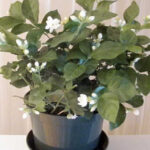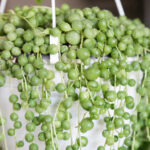We all eat it, but have you wondered how to grow lettuce?
There’s a reason that lettuce is one of the most popular plants to grow. Lettuce is so easy, packed with nutrients, and absolutely delicious, so it’s no surprise we all love to grow this versatile green.
You can grow lettuce in almost any location in the garden – straight in the soil, on the windowsill, or even between your flowers.
With a good focus on gardening basics like proper water, shade, and planting in succession, growing your own lettuce can provide a constant harvest from your garden almost the entire year long. Let’s explore the diversity of lettuce types and find the perfect variety for you!
Good Products To Treat Lettuce Pests/Diseases:
Lettuce: Quick Care Guide
| Common Name | Lettuce |
| Scientific Name | Lactuca sativa |
| Days to Harvest | Depends on cultivar/size of leaf |
| Light | Part sun to shade |
| Water | Regular, about 1” per week or more in hot conditions |
| Soil | Well-draining, humus-rich soil |
| Fertilizer | Nitrogen-rich fertilizers such as fish or seaweed-based liquids or alfalfa meal. Regular applications of compost also recommended. |
| Pests | Aphids, thrips, flea beetles, cutworms, root knot nematodes, snails, slugs, larger animals like rabbits/woodchucks/deer |
| Diseases | Fungal infections like sclerotinia, bacterial infections such as pseudomonas, downy mildew, aphid-borne disease like lettuce necrotic yellows or the lettuce mosaic virus |
Recommended Types of Lettuce
There are many, many types of lettuce available. Whether you prefer to grow lettuce that’s the salad standard of iceberg lettuce (crispheads), or a nice leafy green, there’s going to be lettuce seeds out there for you! Let’s go over some different kinds and see the differences so you can decide which seeds you’ll buy to grow your own lettuce.
Cos Lettuce
The term “cos” is a term for the romaine lettuce and related types of lettuce. These lettuces have an erect growth pattern, with long spoon-shaped leaves that form a tight head pattern. Most are rounded-tipped varieties with a satisfying crunch. Varieties range from pale green to extremely dark red in coloration.
It’s also heat tolerant, while being more nutritious than iceberg lettuce. The hearts of the cos varieties can be used as celery substitutes (although they have a different flavor profile). Romaine lettuce is a classic choice for Caesar salad.
The name “cos” comes from the Greek island of Cos, which is where Romaine lettuce and similar-style lettuces are believed to have originated.
- Breen: 45 days. A mini-romaine lettuce variety which produces bronze-red, oval-shaped leaves. Slow to become oversized.
- Little Gem: 50 days. A popular variety. Often grown to produce extremely tasty romaine lettuce hearts.
- Garnet Rose: 74 days. Can be grown as either a Romaine lettuce or a leaf-type. Garnet-colored savoyed leaves.
- Truchas: 55 days. Striking red-topped leaves with green ribs and veins. No bitterness in flavor.
- Jericho: 56 days. Extremely bolt-resistant and heat-resistant, great flavor, popular romaine lettuce.
- Holon: 55 days. A light green romaine lettuce with dense, upright heads. Downy mildew-resistant.
- Parris Island Cos: 65 days. Heirloom lettuce variety with pale hearts and excellent mild flavor.
- Rouge d’Hiver: 60 days. Heirloom red romaine type from 1885. Bright leaves turn darker red in colder weather.
- Marshall: 65 days. Burgundy, almost purple succulent leaves in a tight upright head formation.
- Freckles: 55 days. Brilliant green leaves with burgundy spotting. Heat-resistant, bolt-resistant.
Loose Leaf Lettuce
Leaf lettuce, also referred to as loose leaf lettuce, doesn’t form as compact and tight of a head. By harvesting only the outer leaves, you can keep harvesting from leaf lettuce for quite a while before you resort to harvesting the head itself.
Leaf lettuce plants are often raised for baby lettuce leaves, but are still quite tasty as full-grown leaves. Leaf lettuce also tends towards unusual shapes and crinkled styles, making it visually appealing. These types of lettuce are easy to harvest continuously throughout the season.
- Cavendish: 35 days. A baby-leaf lettuce variety with sawblade-like dark red leaves. Resistant to downy mildew.
- Sunset: 50 days. A crinkled loose leaf lettuce variety with green striations. Very attractive. Slow to bolt.
- Devil’s Ear: 50 days. Large-spreading loose-leaf lettuce heads with burgundy-colored edges. Crisp texture.
- Winterwunder: 60 days. Very winter-hardy. Large, 9-11″ light green head with curly leaves.
- Black Seeded Simpson: 45 days. Slow to bolt, heat-resistant. Ruffled light green leaves. Popular variety.
- Starfighter: 52 days. Disease, pest and heat resistant, with medium-sized head growth and good flavor.
- Green Ice: 45 days. Sweet-flavored leaf lettuce with large clusters of ruffled green leaves.
- Merlot: 55 days. Extremely dark red lettuce with crisp, waxy leaves. Good cold tolerance.
- Panisse: 48 days. Lime-green large leaves, high resistance to downy mildew.
- Ashley: 47 days. Bronze to red colored oak leaf lettuce. Great heat tolerance, good for baby greens or salad greens.
Crisp Head Lettuce
The crisp head lettuce is the variety that most of us are familiar with from the grocery store. It’s popular because it does well in hot weather and has thick, crunchy leaves. Unfortunately, head lettuce doesn’t contain a lot of nutrients, although it’s a good source of fiber.
- Crispino: 57 days. An iceberg lettuce-type with medium-sized firm heads. Less susceptible to twisted leaves.
- Iceberg Lettuce: 85 days. The classic “salad lettuce” of the United States. 1894 heirloom crisphead lettuce.
- Pablo: 70 days. Batavian-type lettuce with bronze-purple leaves on the exterior. Beautiful appearance.
- Joker: 60 days. Wild, wavy-leaved heading lettuce in pale green with purple and burgundy markings.
- Great Lakes 118: 75 days. Farming standard for commercial growers. Early spring and late fall lettuce.
- Coastline: 32 days. Frillice or frilly-leaved lettuce variety with a crisp bite. Pretty in salads.
- Igloo: 70 days. Quick-growing lettuce, heat resistant. Good mild flavor and bright green coloring.
- Rouge Grenobloise: 55 days. Red-tinted crisphead. Cold-hardy, slow to bolt. Old lettuce variety.
- Gondar: 60 days. Heads close early and fill in quickly. Big green crunchy lettuce.
- Red Iceberg Lettuce: 80 days. An iceberg variety with reddish-tinted leaves. Quite pretty.
Butter Head Lettuce
Boston or butter head lettuce is tender lettuce, with bright green outer leaves and a slightly yellow heart. It’s high in vitamins and minerals with an amazing taste. Most of the varieties in the butter head lettuce family need cooler weather and high-quality soil in order to grow well.
- Rex: 50 days. A popular lettuce for hydroponic growing. Slow-bolting, tolerant to tipburn.
- Yugoslavian Red: 60 days. Incredibly wildly colored leaves, buttery and mild flavor.
- Big Boston: 70 days. 1890 variety. Large and tender dark green leaves, great in salads.
- Drunken Woman Frizzy Headed: 55 days. Mint-green leaves tinged with mahogany red, savoyed shape. Crazy name!
- Buttercrunch: 65 days. Buttery-flavored 6-8″ tall slightly crumpled leaves. Pale-colored heart. Long season.
- Deer Tongue: 50 days. Slightly pointed leaves that grow in almost a pinwheel pattern. Compact, slow to bolt.
- Four Seasons: 55 days. Heirloom variety. Outside leaves are tinged red, inside leaves are yellow.
- May Queen: 50 days. Tender, yellow centers with rose tints. Sweet buttery flavored heirloom.
- Tom Thumb: 50 days. Miniature butterhead lettuce which makes baseball-sized tasty heads. Good for salads.
- Summer Bibb: 43 days. Popular traditional butterhead lettuce variety with light green leaves. Often self-blanches in the center.
Stem Lettuce
This style of lettuce is unusual as it’s not grown for its leaves – it’s grown for the stem! Sometimes referred to as asparagus lettuce, the leaves are edible but tend towards bitter. However, when peeled, the stem itself is crisp, tasty, and tends to be sweet. Used in a lot of Asian cooking, and in China, it’s referred to as “wosun”.
- Celtuce: 75 days. A Chinese stem lettuce grown not for the leaves, but for its tasty stalk.
- Summer 38: 75 days. Another Chinese stem lettuce which is tolerant to both heat and cold. Slow-bolting.
Unusual Lettuce Types
There’s so many types of lettuce that there’s no possible way I can feature them all. However, these varieties deserved a mention. Most of these varieties are hybrids of two different styles of lettuce mentioned above. Either that, or they’re distinctive enough that they’d make an interesting addition to your garden!
- New Yu Mai: 60 days. Taiwanese variety with sword-shaped leaves and a mildly bitter flavor.
- Australian Yellow: 55 days. Bright yellow-green loose-leaf variety. Heat tolerant and bolt-resistant.
- Taiwan Sword Leaf: 60 days. Also known as Oriental lettuce, it has long and pointed bright green leaves.
- Flashy Butter Oak: 55 days. Oak-leaf shaped leaves with a cos growth habit. Stunning in gardens.
- Rouxai: 47 days. Lobed dark red leaves with a bright green interior. High resistance to downy mildew and some pests.
- Sanguine Ameliore: 60 days. Also called Strawberry Cabbage lettuce. 19th century French heirloom, very pale yellow with rose spotting.
- Midnight Ruffles: 45 days. So purple it’s almost ebony, deeply crinkled leaves, and pale hearts.
Planting Lettuce
Getting your lettuce off to a good start is the best way to ensure you’ll have an abundant crop. Here’s exactly how to do it!
As lettuce is a cool-weather crop, it’s important to time when you begin planting lettuce to fit within those cooler temperatures. Lettuce seeds will not germinate at soil temperatures above 80 degrees. In some areas, you may be able to grow lettuce year-round, but in most locations, you will want to plant your lettuce seeds as soon as the ground is able to be worked.
You can start growing lettuce plants in advance, 4-6 weeks prior to the final frost, and transplant them out once the ground is able to be worked.
Plant lettuce seeds in succession every 2 weeks to ensure you grow lettuce and have a consistent crop throughout the growing season. As the weather warms up, switch to more heat-resistant varieties of lettuce.
When the summer heat is starting to subside, you can get another crop of lettuce in. Be sure that the soil temperature has dropped below 80 degrees, and plant lettuce seeds. If you’re in an area which doesn’t get heavy freezing conditions, your growing season can continue throughout a lot of the winter, too!
Lettuce does extremely well in raised bed gardens, but while it tolerate spring and fall sun, it needs protection from summer’s harsh rays. If you plan on trying to grow lettuce seeds into the hot weather months of the year, pick a shady portion of your yard in which to grow lettuce. This will protect it from the elements.
You can grow lettuce seeds directly in ground-level garden beds, but if you do that, be sure to keep a watchful eye out, as slugs and snails are very happy to eat all your young crops and lettuce seedlings!
To plant lettuce seeds, you first need to ensure your soil is prepared. It should be loose and well-draining, and you will want to make sure it’s well broken up. Large clods of soil can slow down germination and make it hard to grow lettuce. Amend your soil with compost or other soil nutrients about a week prior to planting lettuce for best success.
Direct sow your lettuce seeds 1/4″ to 1/2″ under the surface. You can broadcast lettuce seeds for a larger area, or you can plant lettuce in rows, depending on your preference. If you broadcast lettuce seed, you will need to use a rake to bury the seed 1/4″ to 1/2″ under the soil’s surface.
As the lettuce seeds germinate and lettuce plants begin to come up, thin them according to their type. Looseleaf lettuces should be spaced about 3-4″ apart. Cos or other loose-headed lettuce varieties should be spaced 8″ apart, and firm types should be 16″ apart.
Once your lettuce seeds are planted, water them in lightly and regularly water them every few days until germination. Sow every 2-3 weeks for a continuous way to grow lettuce and harvest lettuce throughout the season.
Caring For Lettuce Plants
Lettuce grows almost as readily as grass in most areas. But it can be tricky to maintain it in warmer locations. Follow these tips for the best chance of success when you grow lettuce!
Sun and Temperature
In the cooler months, lettuce grows just fine in full sun, but as it starts to warm up, the sun’s rays will scorch your tender leaves. I opt to grow lettuce in shadier locations year-round, just to get the most out of those areas which won’t usually provide much produce. While it’s good for your lettuce to have at least an hour or two of sun during the day, pick locations where the peak sunlight periods aren’t going to harm your tender salad greens.
Lettuce grows best in the temperature range between 45 and 65 degrees best. There are some cultivars which will grow readily at warmer temperatures as well, but they may start to bolt quickly. Once temperatures are over 80 degrees consistently, grow lettuce plants in the shade and be sure that they have lots of air around them to keep them cooler.
Watering and Humidity
Water makes up the majority of your lettuce’s crisp salad greens, so growing lettuce requires regular watering. Never allow the soil to completely dry out — while your lettuce grows, you want it to have consistent and regular moisture to draw on. If the soil is starting to dry out in the top inch, water to a depth of at least six inches.
It’s important to mulch around your lettuce to keep the soil moist and give your plants the best chance of success. Try to leave at least an inch or two around the base of your lettuce plant bare of mulch, so that it isn’t right up against the leaves. However, the mulch will help keep moisture in around your plant and protect against weeds.
Soil
Because it’s growing so quickly, all types of lettuce can use up a significant amount of soil nutrients. Most lettuce likes humus-rich soil with a high nitrogen content. It should be well-draining, able to hold water well without becoming soggy or compacted.
Prior to planting and growing lettuce, it’s advisable to work some aged compost in about 6″ below the soil’s surface. You can also add alfalfa meal or other nitrogen-rich additives in at this point, about a week before you plant lettuce. This will help give a good start as it begins growing lettuce.
Fertilizing Lettuce
The initial pre-sowing fertilization is the most important. However, if you want to maintain healthy growing lettuce and succession-plant lettuce in your beds, you’ll need to side-dress with a high-nitrogen fertilizer a couple times during the season. Using a nitrogen-rich aged compost will work well for this purpose.
You can also opt for a liquid fertilizer when you’re growing lettuce. Don’t apply this directly to the leaves of your lettuce plants if you’re planning on harvesting lettuce soon, though – apply directly to the soil around the plants. Fish or seaweed emulsions work very well, as does a rich compost tea. If your lettuce plants are young or you’re working with lettuce seedlings, fertilizing the leaves themselves is alright, but don’t fertilize within five to seven days of harvesting.
Pruning Lettuce
Looseleaf lettuce varieties are the only ones that typically require pruning. The cos or headed varieties are going to form heads that you will harvest as a whole, but the leafy types need regular trimming to keep them growing lettuce leaves. It’s best to prune your leaves when they’re 3-4″ in size, but you can harvest leaf lettuce up to 6″ without any bittering of the flavor.
When pruning, trim from the outside, leaving the inner leaves intact. This will encourage your plant to keep producing more leaves from its center, and as they mature, they will replace the removed outer leaves.
You can trim back the entire plant lettuce to about 1-2″ from the ground once it reaches 3-6″ in height, which should be roughly every 10-18 days. This method is referred to as “cut and come again”, and the plant will rapidly regrow, giving you a regular harvest.
If the plant begins to produce a seed stalk, it’s time to remove that plant unless you wish it to produce seed. Any pest-damaged, wilted, or otherwise problematic leaves on the plant can be pruned out at any time. Don’t try to keep growing lettuce after it bolts as it will taste bitter and unpleasant.
Lettuce Propagation
Lettuce propagates through seed, and only through seed. If you are growing lettuce of only one variety, you shouldn’t have cross-pollination issues, so you can save seed for the next growing season. But if you’re growing a number of lettuce types as most of us do, you will want to purchase new seed rather than save your own, as it may form unusual and less-favorable hybrids.
If you start seed in advance, you can easily transplant out lettuce into your garden beds once it’s ready. Space your loose-leaf varieties no closer together than 4″, cos or romaine lettuce no closer than 8″, and firm-headed lettuce varieties 12-16″. Be sure that there’s ample amount of space for your lettuce plants to breathe. For container-grown lettuce, we recommend you plant lettuce starts into a tiered GreenStalk to save space. Do not plant lettuce lower than the soil level in the pot — keep the transplant flush with the soil’s surface around it.
If you’re growing lettuce only for baby leaf production, you may be able to grow your loose-leaved varieties closer together. Pay close attention if you do this, though, as too tightly-packed of a lettuce bed can become infested with various mildews or pests quickly.
How to Harvest Lettuce and Store Lettuce
The most difficult part of growing lettuce, and harvesting and storing lettuce is that no matter what you do, it won’t last for very long! Read on to find out how to harvest lettuce and store it too. I’ve also included a list of ways to use up the excess lettuce you may find on hand.
Harvesting Lettuce
It’s best to harvest your lettuce early in the morning when it’s at its crispest. Overnight cooler temperatures will have allowed your lettuce to suck in moisture and firm up. Later in the day, even the nicest-looking leaf lettuce will be softer than you’d prefer.
You can harvest leaf lettuce as directed in the “pruning” section up above, using a sharp pair of scissors. Head varieties can either have outer leaves trimmed off for immediate use or can be grown until the full head has developed.
To harvest full heads of Romaine lettuces or Icebergs, you can opt to either cut off the lettuce at its base, or to pull the plant out roots and all. If removing the whole head, you will need to use a sharp knife to cut it off at the soil’s surface. More lettuce leaves may regrow from the base.
Pulling it out by the roots does make it easier to start another batch of lettuce in the same location after adding a bit more compost to the soil, so if you are succession planting, it might be be easiest to use this method and compost your roots.
Deciding when to harvest your heads of growing lettuce is as simple as giving them a gentle squeeze. A head which is not quite ready will easily compress under your fingers. Cos or butterhead lettuce varieties can either be harvested leaf by leaf, or can be harvested as a whole head when they are semi-firm but not solid. Crisphead lettuce should be harvested when the lettuce is firm.
It’s best to harvest your lettuce early rather than letting it go later. The older the lettuce leaves, the more bitter they will get, and it can become tough or woody. Pay attention to the estimated days to maturity on your lettuce seed packet, and try to harvest it at or just before that date hits.
Storing Lettuce
One of the most troublesome aspects of lettuce is that it is best when really fresh. This is especially true of loose-leaf lettuces, which are best eaten the day that they’re picked.
However, you can store loose-leaf lettuce for a few days if needed. Begin by filling a bowl full of cold or cool water. Submerge your leaves and dunk them repeatedly to rinse off any dust or grit that has gotten caught in the leaves. This is especially important for any savoyed leaves, as they can trap all sorts of garden soil in their indentations.
Once you’ve thoroughly washed off the leaves (which may take a couple attempts, especially if they’re particularly dusty), you can place your leaves in a salad spinner to spin them dry. Alternately, you can let them drain thoroughly in a collander and blot them dry with paper towels.
It’s essential that your leaf lettuce is completely dry before storing. Once it’s dry, place your leaves between paper towels to absorb any stray moisture, and then place them in a sealed plastic bag. Be sure to press out all excess air. This will help you preserve your leaf lettuce for a few days’ time.
Romaine lettuce or crisphead lettuce is best used shortly after harvest as well, but can be stored as well. If you cut it off at the base, a full head of crisphead lettuce can be stored wrapped in paper towels in a sealed plastic bag in the refrigerator for up to a week. Cos lettuce can also be stored this way, or broken down into individual leaves and stored as you would with a loose-leaf variety.
If any of your stored lettuce has started to wilt, don’t panic! Simply prepare a bowl full of ice and ice water and soak your lettuce leaves in it for about 15-30 minutes. They will soak up the moisture and crisp back up.
Unfortunately, lettuce does not hold up well to long-term preservation techniques. However, if your lettuce is wilting faster than you’re making salads, you can use your lettuce greens up quickly by making a creamy lettuce soup or by making a stir-fry with them. While most people do not think of lettuce as being something which is meant to be cooked, it can be treated like spinach or other wilting greens, and can make a tasty side dish or a lightly-sweet soup.
There are people who have dehydrated lettuce to make a lettuce powder to add to smoothies or other power drinks, and that is an option, but it will not provide much flavor to your beverages. Still, if you have an abundance of lettuce, this might be an option for you!
You can also use this method to try to make lettuce “chips”, but as they crumble in your fingers, this may be more trouble than it’s worth; using them as a powder is easier.
Dehydrated lettuce does not rehydrate very well. It’ll be limp and unappetizing. It’s best to use it in its dried form.
Troubleshooting
Lettuce should be pretty easy to grow. But what if it’s not? Here’s a list of common issues you may encounter and how to handle them.
Lettuce Growing Problems
One of the most common problems is poor germination. This occurs when you’re not watering consistently or frequently enough while trying to sprout new lettuce plants. The soil must be consistently and evenly moist for best germination. While some types of lettuce have lower rates of germination than others, the majority typically have about an 85% germination rate, so your watering habits are likely the issue.
If the edges of your leaves are turning brown, you’re experiencing tip burn. This is usually caused by inconsistent watering. Using a drip irrigation system regularly can reduce the likelihood of tip burn. Planting resistant cultivars that can tolerate warmer conditions can also stop this problem.
Check your lettuce plants on warmer days. If you see signs of wilting, they’re probably in need of water. You can spritz lettuce with a fine mist of water to perk it up on those hot weather days, but it’s important to pair that spritz with a good base watering as well so they have plenty of moisture.
However, in wetter conditions during the rainy spring and fall months, wilting may be a sign of too much water. A lack of good drainage can cause your roots to develop rot, and that will ruin the lettuce plant. If the weather is mild, don’t water until you’ve checked your soil moisture. It’s possible to ruin your harvest by overwatering!
Is your lettuce turning yellow — and it’s not a yellow or yellow-green variety? It may be hungering for a good dose of nitrogen. Try giving it some compost tea or a fish or seaweed emulsion fertilizer at the base of the lettuce plant. It should green back up.
To prevent bolting during hot weather months, try to plant lettuce lettuce beneath taller leafy plants like tomatoes to give it shelter from the hot sun. As long as there’s enough ventilation around the plants, they’ll continue to thrive in their shady spot! You can also opt to use a floating row cover to provide shade, but be sure that the ends are kept open to provide airflow.
If you find your lettuce tastes bitter or is woody in texture, it’s too old. You need to harvest lettuce while the leaves are tender and flavorful, before they begin to bitter. Harvest earlier and more consistently for the best flavor.
If the crown of your lettuce is starting to elongate, it’s about to bolt to seeding lettuce. At this point, your lettuce plant is past its eating prime and should be removed unless you plan on harvesting seed from it.
Finally, if you’re in an area where you get a bone-chilling winter, be sure to put a cold frame over your lettuce to give it some warmth. While many types of lettuce are cold-resistant, temperatures below 25 degrees regularly can still cause your lettuce plants to fail, and hard freeze conditions will ruin your leaves. If necessary, you can move your plants indoors. Place them in an area with indirect bright lighting like a window, and make sure the temperature range is between 45-65 degrees for best growth.
Pests
Aphids are a common pest on lettuces, and for that matter nearly any green and leafy vegetable. These tiny pests suck the fluids out of tender lettuce leaves and stems. To combat these, spray all surfaces of your lettuce with neem oil. Consider planting aphid-repelling plants like chives or garlic near your lettuce bed. Plants like cilantro or dill will lure in beneficial insects to eat your aphid population.
A thorough application of neem oil will also reduce the presence of thrips, another sucking pest. Thrips will scar your lettuce or cause it to yellow and wilt.
The flea beetle will eat holes through your lettuce leaves. Since we all want to eat our own produce, that’s not a good thing! Use a spinosad spray to deal with these tiny jumping beetles.
Cutworms will nibble right through the base of your young lettuce shoots or lettuce seedlings. While there are ways to prevent these caterpillars using plant collars or other similar things, I recommend spraying your plants with a bacillus spray. This will kill off the larval stages of cutworm moths and many other caterpillars.
Root knot nematodes and other pestilent forms of nematodes can take up residence in the soil beneath your plants. These attack the roots, causing knotting, scarring, and large nodules to develop on the roots and preventing your lettuce plant from absorbing nutrients. Spreading beneficial nematodes will help to wipe out the population of the pest nematodes, as they will seek out and kill the other varieties. They will also attack pupae in the soil, making another line of defense against cutworms or other pests.
Slimy slugs and snails will eat huge gouges out of your lettuce leaves if given half a chance. There’s multiple different methods to prevent these, but all of them involve bait. Spreading a granular bait will distract them from your produce, and when they eat the bait, they die. You can also half-bury a container of old beer in your lettuce patch, and when snails or slugs are drawn by the smell of the beer, they will drown.
Not all lettuce pests are insects. Rabbits, woodchucks, and deer can all be drawn to your lettuce beds, and will helpfully eat anything you have there. There are many different options to keep these much larger garden-munchers at bay, but one of the easiest is to place floating row covers over your lettuce bed. That keeps other insect pests out, too!
Diseases
One of the early diseases which can impact your lettuce is damping off. Caused by a soilborne fungus, it thrives in cool, damp and cloudy conditions. Your lettuce seedlings will wilt and fall over. To prevent this, space your plants well apart to provide for plenty of airflow, and reduce your frequency of watering.
Sclerotinia is another fungus which can impact your plants. There are a few varieties of sclerotinia. The most common for lettuce is sclerotinia stem rot, which can cause a whitish mold to appear along the stem and base of your plant. The treatment for this fungal disease is much the same as damping off – space your plants wide enough to allow for plenty of air to move around them, and reduce the frequency of watering. Remove affected plants and destroy them. Do not compost them.
The pseudomonas bacteria can cause base rot and leaf rot, as shown in the picture above. If you are seeing signs of this, pull and destroy affected plants, and spray the remaining plants with a copper fungicide. This will reduce the rate of bacterial spread and should save your other plants. Rotate your lettuce out of that location for future plantings.
Downy mildew will cause light green to yellow spots on the top of lettuce leaves. Underneath the leaf, white mold forms on the bottom of the leaf spots. Trim off any affected leaves and destroy them. Treat the rest of the plant copper fungicide to reduce further spread.
Finally, lettuce necrotic yellows and the lettuce mosaic virus are both diseases carried by aphids. To be sure your plants will not contract these diseases, be sure your lettuce is aphid-free by regularly spraying the leaves with neem oil to repel them. Floating row covers can also protect your lettuce from aphids or other pest insects.
Frequently Asked Questions
Q: How long does it take to grow a lettuce?
A: Depending on the variety, it takes anywhere from 30 to 70 days to grow lettuce.
Q: What is the best way to grow lettuce?
A: Give lettuces lots of light and water, and a little bit of fertilizer, and you have all you need to grow lettuce.
Q: Does lettuce need full sun?
A: Most varieties need full sun, and to err on the safe side, grow lettuce in full sun. There are a few that have been cultivated to grow in shadier conditions, though.
Q: Does lettuce need a lot of water?
A: Grow lettuce with a moderate amount of water. It can stay on the same watering schedule as your other spring and fall annuals.
Q: Does lettuce grow well in pots?
A: Because all varieties have shallow roots, you can easily grow lettuce in grow bags and other containers.
Q: What month do you plant lettuce?
A: You want to plant it in the months that fall 2 weeks before the last frost and about 4 to 6 weeks before the first frost.
Q: How many heads of lettuce should I plant?
A: General planting guides will say to plant seeds to grow no more than one head of lettuce per square foot. However you may be able to get away with planting slightly closer and obtain a higher yield. Check the type on your seed packet and see the spacing section of the Planting part of this piece to determine if your butterhead lettuce or loose leaf can be planted more intensively in your garden beds.
Q: How do you cut lettuce so it keeps growing?
A: Remove only the outer leaves, leaving at least 1/3 of the leaves there. Note this doesn’t necessarily apply to head lettuces which might grow in a way where it isn’t possible to harvest just outer leaves. This harvest method is best applied to butterhead lettuce and leaf lettuce.









